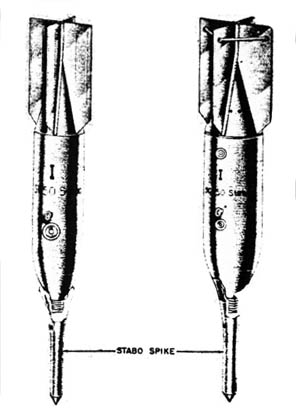SC500 bomb on:
[Wikipedia]
[Google]
[Amazon]
The SC 500 ( Sprengbombe Cylindrisch) or ''cylindrical explosive bomb'' in English was a family of
 They had three-piece drawn steel bodies with a heavy machined nose cap for armor penetration. At the other end was a base plate, just forward of which the magnesium alloy tail was tack welded onto the body, and also bolted to the tail attachment brace. The bomb was usually filled with a mixture of 40%
They had three-piece drawn steel bodies with a heavy machined nose cap for armor penetration. At the other end was a base plate, just forward of which the magnesium alloy tail was tack welded onto the body, and also bolted to the tail attachment brace. The bomb was usually filled with a mixture of 40%
general-purpose bomb
A general-purpose bomb is an air-dropped bomb intended as a compromise between blast damage, penetration, and fragmentation in explosive effect. They are designed to be effective against enemy troops, vehicles, and buildings.
Characteristics ...
s used by the Luftwaffe
The ''Luftwaffe'' () was the aerial-warfare branch of the German ''Wehrmacht'' before and during World War II. Germany's military air arms during World War I, the ''Luftstreitkräfte'' of the Imperial Army and the '' Marine-Fliegerabtei ...
during World War II
World War II or the Second World War, often abbreviated as WWII or WW2, was a world war that lasted from 1939 to 1945. It involved the vast majority of the world's countries—including all of the great powers—forming two opposin ...
.
Design
 They had three-piece drawn steel bodies with a heavy machined nose cap for armor penetration. At the other end was a base plate, just forward of which the magnesium alloy tail was tack welded onto the body, and also bolted to the tail attachment brace. The bomb was usually filled with a mixture of 40%
They had three-piece drawn steel bodies with a heavy machined nose cap for armor penetration. At the other end was a base plate, just forward of which the magnesium alloy tail was tack welded onto the body, and also bolted to the tail attachment brace. The bomb was usually filled with a mixture of 40% amatol
Amatol is a highly explosive material made from a mixture of TNT and ammonium nitrate. The British name originates from the words ammonium and toluene (the precursor of TNT). Similar mixtures (one part dinitronaphthalene and seven parts ammoniu ...
and 60% Trotyl
Trinitrotoluene (), more commonly known as TNT, more specifically 2,4,6-trinitrotoluene, and by its preferred IUPAC name 2-methyl-1,3,5-trinitrobenzene, is a chemical compound with the formula C6H2(NO2)3CH3. TNT is occasionally used as a reagen ...
, but when used as an anti-shipping bomb it was filled with ''Trialen Trialen was an explosive developed in Germany. It was used during World War II in the V-1 flying bomb and Arado E.377 glide bomb, among other weapons, as an enhanced blast explosive. Trialen was the German equivalent of the British explosive Torpe ...
105'', a mixture of 15% hexogen
RDX (abbreviation of "Research Department eXplosive") or hexogen, among other names, is an organic compound with the formula (O2N2CH2)3. It is a white solid without smell or taste, widely used as an explosive. Chemically, it is classified as a n ...
, 70% Trotyl
Trinitrotoluene (), more commonly known as TNT, more specifically 2,4,6-trinitrotoluene, and by its preferred IUPAC name 2-methyl-1,3,5-trinitrobenzene, is a chemical compound with the formula C6H2(NO2)3CH3. TNT is occasionally used as a reagen ...
and 15% aluminium powder
Aluminium powder is powdered aluminium.
This was originally produced by mechanical means using a stamp mill to create flakes. Subsequently, a process of spraying molten aluminium to create a powder of droplets was developed by E. J. Hall in the ...
. Around the nose of the bomb was a ''kopfring'' - a metal ring, triangular in cross section, designed to prevent ground penetration or to stop forward momentum
In Newtonian mechanics, momentum (more specifically linear momentum or translational momentum) is the product of the mass and velocity of an object. It is a vector quantity, possessing a magnitude and a direction. If is an object's mass an ...
when hitting water. The bomb could also be fitted with a ''Stabo Spike'' which was an anti-ricochet device that prevented the bomb from burying itself too deep to increase its anti-personnel effectiveness. The bomb was attached to the aircraft horizontally by a H-type suspension lug. It could be horizontally suspended in a bomb bay
The bomb bay or weapons bay on some military aircraft is a compartment to carry bombs, usually in the aircraft's fuselage, with "bomb bay doors" which open at the bottom. The bomb bay doors are opened and the bombs are dropped when over th ...
or horizontally mounted on a wing or fuselage hardpoint
A hardpoint is an attachment location on a structural frame designed to transfer force and carry an external or internal load. The term is usually used to refer to the mounting points (more formally known as a weapon station or station) on the ...
.
References
{{Use dmy dates, date=October 2019 World War II aerial bombs of Germany